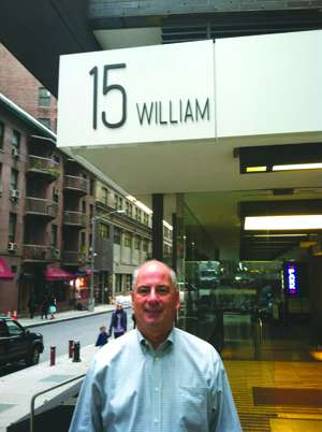Green Award

By Rebecca Temerario John Sarich believes that it's time to give back to his community. That's exactly what he's doing at William Beaver House, where he has been resident manager for the past five years. A native New Yorker, Sarich had previously worked as a resident manager in Queens. The William Beaver House's 47 energy-efficient stories loom large at the corner of William and Beaver streets, in the heart of the Financial District. From the outside, a sleek, low-lighted lobby can be seen, complete with leafy upholstery. The building seems green, but, as Sarich explains, most of being green happens behind the scenes. Sarich says being green "just made sense." When he arrived at 15 William St., the building wasn't green. But, Sarich, who began taking conservation courses at 32BJ's union hall six years ago, used his ingenuity and on-the-job training to transform the building. Sarich, a self-taught electrician, retrofitted many of the building's light fixtures himself. William Beaver House's carbon-reducing changes are all done in-house. In fact, Sarich is responsible for the implementation of LEED light fixtures, timed lighting and motion sensors. He retrofitted some areas of the building with compact fluorescent lamps, or CFLs. In reducing the carbon footprint of the William Beaver House, Sarich says he "focused on a cost reduction and dollars-and-cents approach." Before making the switch to a more environmentally friendly building, Sarich says he "did a cost analysis for payback time" and found that many of the changes were "easily remedied without any capital expenditures." Ultimately, Sarich's goal was to ensure that his additions would lead to "a better environment for his workers and residents." For example, Sarich points out motion sensors used in back hallways throughout the building, noting that previously, "those lights had been on all day." The situation had been the same in maintenance rooms, which Sarich estimated saw only about 20 hours of use per day. Now, the William Beaver House is saving energy and money through efficiency. Through Sarich's implementation of a steam recovery system, the William Beaver House's pool operates at an expense he estimates to be two-thirds cheaper. Pointing out the timed lighting in the yoga studio, workout room and squash court, Sarich remembers how residents would play squash games and leave the light on when they left. Today, the squash court lights turn off automatically after two hours. From 11 p.m. to 6 a.m., the building's hallway lighting operates with bi-level lighting. Some residents noticed the darker-hued hallways, but once Sarich explained the positive effects of conservation, they got on board. Now, Sarich says, "the building only uses green-seal products." The William Beaver House, whose apartments range from studios to three bedrooms, is working on attracting even more environmentally conscious residents. Sarich has been recognized nationally for his accomplishments as a recipient of an EBie Award from the U.S. Green Building Council. However, Sarich isn't looking for recognition. As he greets one of his younger residents, who is equipped with a helmet and scooter, he notices that "she's gotten so big!" It's clear that Sarich has an interest in keeping New York, and the world, clean for the following generations. "This isn't about me, it's about what we're doing," he says. Sarich's green thumb has certainly left an impact on his building, its residents, and the Financial District.